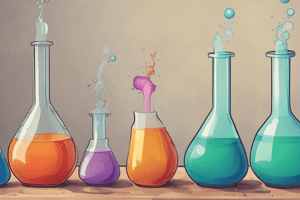Podcast
Questions and Answers
What is a common property of acids?
What is a common property of acids?
- Neutralize bases forming water and salt
- Taste bitter
- React with carbonates to produce CO2 (correct)
- Change red litmus paper to blue
Which statement is true about bases?
Which statement is true about bases?
- Neutralize acids forming water and salt (correct)
- They taste sour
- Change blue litmus paper to red
- Produce hydrogen ions in water
According to Svante Arrhenius, how are acids defined?
According to Svante Arrhenius, how are acids defined?
- Substances that taste sour
- Substances that neutralize bases
- Substances that change red litmus paper to blue
- Substances that dissociate to produce hydroxide ions in water (correct)
Which of the following is NOT a property of bases?
Which of the following is NOT a property of bases?
What happens when acids react with active metals?
What happens when acids react with active metals?
Which is a characteristic of acid solutions?
Which is a characteristic of acid solutions?
According to the Bronsted-Lowry theory, which of the following is the definition of an acid?
According to the Bronsted-Lowry theory, which of the following is the definition of an acid?
Which of the following is an example of a Bronsted-Lowry base?
Which of the following is an example of a Bronsted-Lowry base?
What is the conjugate base of the Bronsted-Lowry acid HCO3-?
What is the conjugate base of the Bronsted-Lowry acid HCO3-?
Which of the following substances is an example of an amphiprotic species?
Which of the following substances is an example of an amphiprotic species?
According to the Lewis theory of acids and bases, which of the following is the definition of a Lewis acid?
According to the Lewis theory of acids and bases, which of the following is the definition of a Lewis acid?
Which of the following is an example of a Lewis acid?
Which of the following is an example of a Lewis acid?
Flashcards are hidden until you start studying
Study Notes
Properties of Acids
- Acids taste sour
- Acids change the color of indicators (blue litmus paper turns red)
- Acids react with active metals, releasing H2 gas
- Acids neutralize bases, forming water and salt
- Acids react with carbonates to produce CO2
- Acid solutions conduct electric current
Properties of Bases
- Bases taste bitter
- Bases change the color of indicators (red litmus paper turns blue)
- Basic solutions feel slippery on the skin
- Bases neutralize acids, forming water and salt
- Base solutions conduct electric current
Arrhenius Acids and Bases
- Acids are substances that dissociate in water to produce hydrogen ions (H+)
- Bases are substances that dissociate in water to produce hydroxide ions (OH-)
- Examples of Arrhenius acids and bases:
- Acids: HC2H3O2, HCl, HNO3, H2CO3, H2SO4, H3PO4
- Bases: KOH, NaOH, LiOH, Ba(OH)2, Ca(OH)2, Mg(OH)2, NH3
Bronsted-Lowry Acids and Bases
- Acids are substances capable of donating a proton (H+)
- Bases are substances capable of accepting a proton
- Examples of Bronsted-Lowry acids and bases:
- Acids: HCl, HCO3-, H2PO4-, HSO4-, HF
- Bases: H2O, NH3, PO4-3, NH4+, Cl-
- All Arrhenius acids and bases are classified as Bronsted-Lowry acids and bases, but not all Bronsted-Lowry acids and bases are Arrhenius acids and bases
Amphiprotic Substances
- Amphiprotic substances are molecules or ions that can act as both acids and bases
- Examples of amphiprotic substances: HCO3-, H2PO4-, HSO4-
Conjugate Acid-Base Pair
- A conjugate base is the species that results when an acid donates a proton
- A conjugate acid is the species that results when a base accepts a proton
Lewis Acids and Bases
- Acids are substances that accept a pair of electrons
- Bases are substances that donate an unshared pair of electrons
- Examples of Lewis acids: molecules with incomplete octets, such as BF3 and AlCl3
Studying That Suits You
Use AI to generate personalized quizzes and flashcards to suit your learning preferences.




